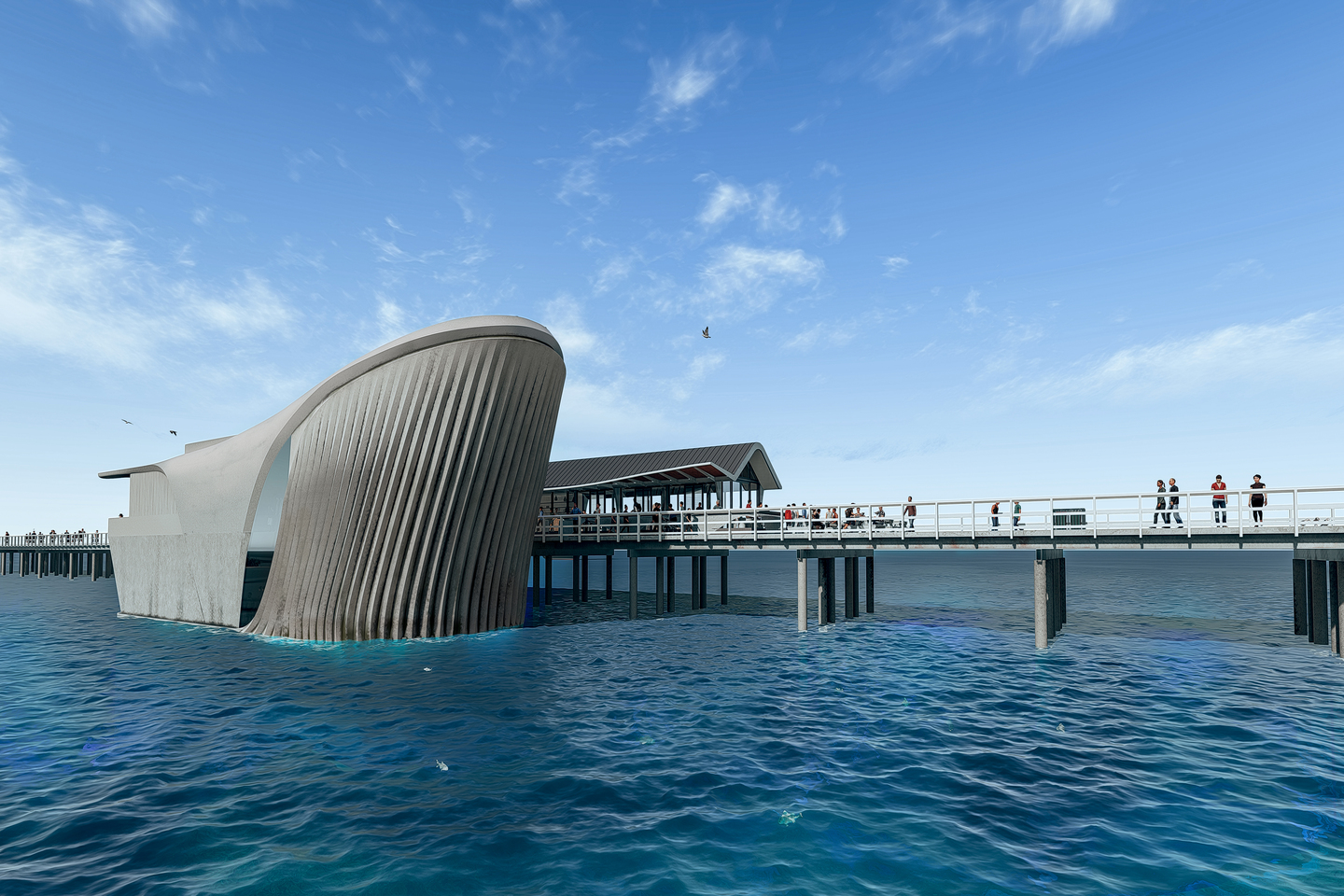EXCLUSIVE: It was set to kickstart tourism post-COVID, but a plan to build Australia’s largest marine observatory in Busselton is in jeopardy after coming in $20 million over budget.

It was touted as a means of kickstarting tourism post-COVID, but a plan to build Australia’s largest marine observatory is struggling to stay afloat and evade the state's overheated construction market.
For the past five years, the not-for-profit behind the Busselton Jetty has been progressing a $32 million plan to build a four-storey whale-shaped observatory, complete with an outdoor terrace, function room, an art gallery and a restaurant.
The structure would be an expansion of the existing 17-year-old observatory at the 156-year-old jetty, which would be converted into a marine research centre promoting clean oceans and a laboratory to educate people about oceanic climate change.
The observatory was set to be fabricated by Henderson-based subsea solutions company Subcon Blue Solutions and towed 185 kilometres to Busselton, before being installed in eight metres of water 1.7 kilometres along the jetty.
The plan gained the assent of several government agencies and the City of Busselton, recognised as an opportunity to kickstart tourism, better accommodate the increase in visitation and boost revenue.
With it came the promise of economic benefits, supporting almost 200 jobs during construction and hundreds more once operational and injecting more than $1 billion into the state’s economy.
But just days before the plan was due to receive the final tick of approval from the regional development assessment panel, contractors Subcon advised BJI’s board the project's cost had increased by more than 50 per cent.
Like a swathe of other major construction projects, the observatory is at the mercy of the overheated construction market; experiencing a 63 per cent increase in materials costs, a 280 per cent increase in shipping costs and a 40 per cent increase in the cost of labour.
With its construction anticipated to take 14 months and the federal government’s $13 million grant due to expire in June 2023, the future of the project now hinges on BJI’s ability to source $20 million by mid-February.
Search for funding begins
Busselton Jetty Inc chief executive Lisa Shreeve confirmed the board had begun approaching numerous parties for additional funding, including the state government; which has supported the project to the tune of $9.5 million.
In response, Premier Mark McGowan and Minister Alannah MacTiernan recommended the board attempt to rescale the project, or that at the very least it be paused until the market cools down.
But Ms Shreeve explained the board’s hands were tied.
“If we put the project on hold, we may lose the federal funding,” she said.
“We cannot really rescale a giant whale.
“We’re just continuing to fight until the middle of February, and if we’ve exhausted all our avenues and we haven’t won the Powerball, we may have to look at just building the village component, which is the food and beverage area.
“But the observatory is the drawcard, it’s what is more important to us because it’s all about marine conservation and telling that story.”
The project was the product of several years of investigations regarding how the BJI could meet increasing visitor demand, with a survey of more than 12,000 visitors at Perth Airport concluding that capitalising on the jetty's current marine offering was the best way to do so.
It was hoped the structure would draw more than 200,000 new visitors in 2023, bringing visitation to the Jetty to more than 900,000 visitors annually.

Light at the end of COVID tunnel
The current observatory at the Busselton Jetty is the largest natural aquarium in the world, one of just six in existence.
But the 17-year-old structure is no longer capable of servicing the current demand, with a capacity limit of 44 people per hour.
During the peak season, Ms Shreeve said the observatory was booked out for weeks at a time, with visitors having to be turned away.
And Ms Shreeve said it was all the more critical that the infrastructure was upgraded now, with the reopening of international borders and heightened competition for tourists.
“Post COVID, we’re already behind the eightball in WA because our borders are opening late,” she said.
“If and when things get back to normal, what is going to attract people around the world to WA?
“We considered this the post-COVID catalyst to draw people to WA, to choose the Margaret River region over the Hunter Valley or the Great Barrier Reef.
“We just believe it has huge appeal, particularly to the Asian market, and a bigger observatory and a better experience would be the catalyst for getting them here.”
Ms Shreeve said the project had been the light at the end of the tunnel for Busselton’s tourism sector, which typically draws 44 per cent of international tourists to the state but had struggled amid COVID border closures.
“We worked incredibly hard to build our Asian market up with Singapore, Malaysia and China becoming our biggest visitor base – they love the open space of the Jetty, the turquoise water and most of all being able to walk 8m underwater with their clothes on in our underwater observatory,” she said.
“The light at the end of our COVID tunnel has been that we had secured $32m to build a new bigger Australian Underwater Discovery Centre that would become a bucket list location educating hundreds of thousands of people per year about marine conservation and clean oceans.
“But now the whole project is in jeopardy, including our wonderful marine science research work, which is funded from ticket sales, too.”
BJI is now seeking interest from corporates who may like to invest in the project, which has 100 per cent tax deductible status, partnering in marine research, public engagement or tourism recovery.
















